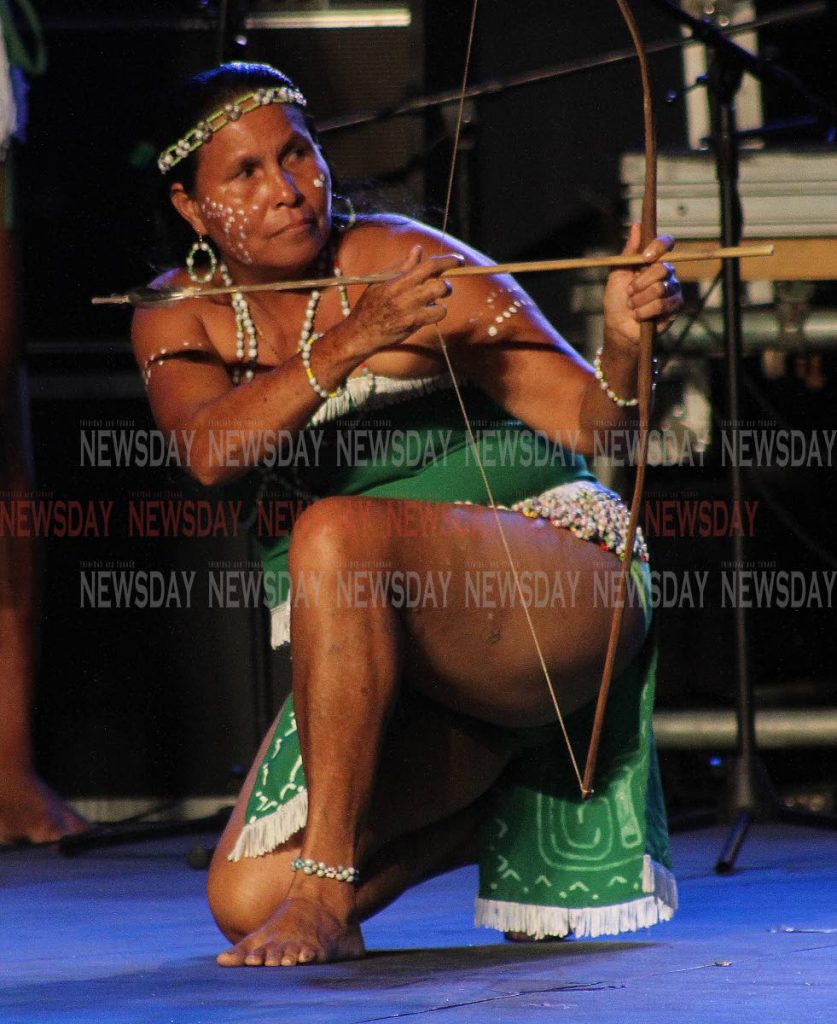Much bonhomie at Carifesta 'French' night

NO ONE could doubt the enthusiasm of contingents from the French-influenced Caribbean in their high-energy performances at Carifesta XIV at Queen’s Park Savannah, Port of Spain on Tuesday night.
It was truly an invaluable experience to see singers, dancers, musicians and dramatists who were Caribbean but spoke French and French Creole.
Those featured were Guadeloupe and Martinique, departments of France, but in addition it was a revelation for many TT nationals to see how French the cultures of Dominica and St Lucia are.
The fact of a common underlying Caribbeanness being offered with a French flair may best have been seen in Dominica’s lady of song, Ophelia Marie, singing in French/French Creole the song Dingolay penned by the late Tobago-born Winston “Shadow” Bailey.
It was truly a night to look out for similarities and differences in song, dance and dress between the francophone and anglophone areas of the Caribbean, plus the bilingual/bridging territories of St Lucia and Dominica. For example, while performers’ Carnival costumes could easily be envisioned within a Trinidadian band, also being worn by many artistes was the madras fabric so typical of the French-influenced islands.
Martinique offered a small band of five or six members including a female singer and an excellent flute soloist, all with very eclectic offerings. Reports are their accompanying dancers were absent because ofto travel difficulties.
Listeners at the far ends of the Grand Stand were a bit distant to hear the performance fully, even as initially a huge central swath remained empty, as it had been cleared of seats. But by the end of the night that section was filled with happy patrons opting to sit on the wooden flooring, which also afforded space for those wishing to "free up."
Guadeloupe offered a tasty mix of food, fashion and music, all under the theme of Caribbean Butterfly, a theme based on the shape of Guadeloupe’s islands. A dozen or so men, sporting bright waistcoats and hats, blew two trumpets and a conch shell and beat out a lively rhythm on drums, all wonderfully raw, earthy and rousing. Truly, the band Guadeloupe Vibrations could find a place in TT Carnival, to help us stay connected to our roots in this era of big trucks and big sound systems.
Four girls danced in carnival costumes. At one stage, supported by vocals from a backing band, some eight women strutted their stuff to showcase the offerings of Guadeloupean fashion designers, no haute couture, but wearable and practical. Several chefs in front of the stage offered free delicacies to patrons during the performances.
The group was accompanied by Guadeloupe Minister of Culture Bredent Georges. Speaking through his interpreter Rachel Baptiste, he told Newsday how glad he was to be here to showcase Guadeloupe and how well he thought the performance had gone.
Dominica, on next, proudly displayed its African and Amerindian heritage, with an enthusiastic flagman front stage. Six indigenous Kalinago performers from the Karifuna Cultural Group came on sporting bows and arrows, to the backing of hand drum and chac-chac.
Next came eight women clad in billowing and elaborate traditional market dresses. They danced to the backing music of the band Signal, whose vocalists sported neat madras waistcoats.
Signal’s grooving, feel-good, jump-up song was well delivered in a polished performance through an excellent sound system.
The contingent’s announcer said the local music styles were called cadens and bouyon, while Newsday was told the dance style was bélé, as in TT.
Then, to drum and conch, several traditional Dominican carnival characters pranced on stage, largely reminiscent of traditional TT characters such as gorillas, cows and clowns, with a group wearing hats resembling those worn by Tobago speech bands, while others wore streaming ribbons which invoked the spiritedness of TT’s pierrot grenade.
St Lucia came next, performing La Woz, which in Creole means The Rose. It is a flower festival that includes characters such as a king and queen and police. Performer Ayanna Alexander told Newsday her group’s offering was a traditional St Lucian performance.
Soca star Teddyson John’s song was lapped up by the audience.
The night’s performances, plus the nearby food stands and tourism booths of each country’s offerings, created a safe and relaxed environment, and a very welcoming and expansive mood for guests.
Going forward, countries will have to see how to put fresh, modern twists on their traditional sounds and sights, to avert any sort of “Best Village” sameness to the fare and to show how these regions of English, French and Dutch (and formerly Spanish) heritage have diversified over the past 300 years.


Comments
"Much bonhomie at Carifesta ‘French’ night"